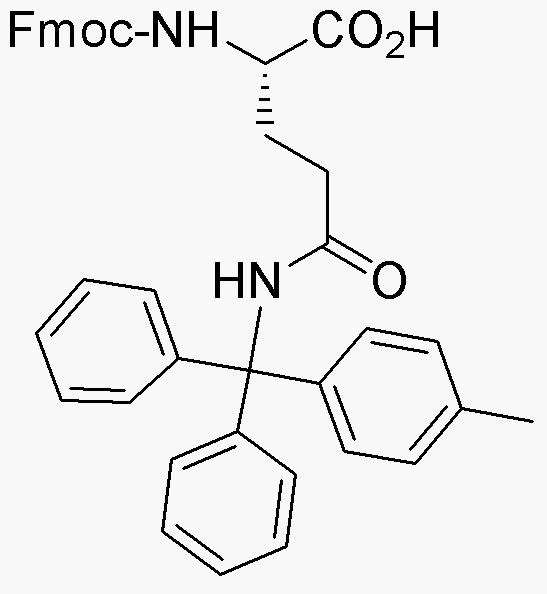Na-Fmoc-Nd-methyltrityl-L-glutamine is widely utilized in research focused on:
- Peptide Synthesis: This compound serves as a key building block in the synthesis of peptides, allowing researchers to create complex protein structures for various studies.
- Drug Development: It plays a significant role in pharmaceutical research, particularly in the design of new drugs that target specific biological pathways, enhancing therapeutic efficacy.
- Biotechnology: In biotechnological applications, it is used for the production of recombinant proteins, which are crucial for developing vaccines and therapeutic agents.
- Analytical Chemistry: The compound is employed in analytical methods to study protein interactions and stability, providing insights that are vital for both academic and industrial research.
- Material Science: Its unique properties make it valuable in creating novel materials with specific functionalities, such as drug delivery systems that improve the bioavailability of therapeutic agents.
General Information
Properties
Safety and Regulations
Applications
Na-Fmoc-Nd-methyltrityl-L-glutamine is widely utilized in research focused on:
- Peptide Synthesis: This compound serves as a key building block in the synthesis of peptides, allowing researchers to create complex protein structures for various studies.
- Drug Development: It plays a significant role in pharmaceutical research, particularly in the design of new drugs that target specific biological pathways, enhancing therapeutic efficacy.
- Biotechnology: In biotechnological applications, it is used for the production of recombinant proteins, which are crucial for developing vaccines and therapeutic agents.
- Analytical Chemistry: The compound is employed in analytical methods to study protein interactions and stability, providing insights that are vital for both academic and industrial research.
- Material Science: Its unique properties make it valuable in creating novel materials with specific functionalities, such as drug delivery systems that improve the bioavailability of therapeutic agents.
Documents
Safety Data Sheets (SDS)
The SDS provides comprehensive safety information on handling, storage, and disposal of the product.
Product Specification (PS)
The PS provides a comprehensive breakdown of the product’s properties, including chemical composition, physical state, purity, and storage requirements. It also details acceptable quality ranges and the product's intended applications.
Certificates of Analysis (COA)
Search for Certificates of Analysis (COA) by entering the products Lot Number. Lot and Batch Numbers can be found on a product’s label following the words ‘Lot’ or ‘Batch’.
Número de catálogo
Número de lote/lote
Certificates Of Origin (COO)
This COO confirms the country where the product was manufactured, and also details the materials and components used in it and whether it is derived from natural, synthetic, or other specific sources. This certificate may be required for customs, trade, and regulatory compliance.
Número de catálogo
Número de lote/lote
Safety Data Sheets (SDS)
The SDS provides comprehensive safety information on handling, storage, and disposal of the product.
DownloadProduct Specification (PS)
The PS provides a comprehensive breakdown of the product’s properties, including chemical composition, physical state, purity, and storage requirements. It also details acceptable quality ranges and the product's intended applications.
DownloadCertificates of Analysis (COA)
Search for Certificates of Analysis (COA) by entering the products Lot Number. Lot and Batch Numbers can be found on a product’s label following the words ‘Lot’ or ‘Batch’.
Número de catálogo
Número de lote/lote
Certificates Of Origin (COO)
This COO confirms the country where the product was manufactured, and also details the materials and components used in it and whether it is derived from natural, synthetic, or other specific sources. This certificate may be required for customs, trade, and regulatory compliance.


